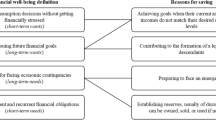Abstract
This article develops a model of asset allocation relevant for the representative consumer. Consumption is composed of two items: housing, and other goods and services. The representative household's balance sheet consists largely of a house and a mortgage. Its income statement is dominated by labor earnings, constraining cash expenditures. Housing-market behavior thus underlies intertemporal wealth and consumption allocation. With a housing-dominated portfolio and a maximizing plan, a plausible bound on the intertemporal marginal rate of substitution in consumption can be estimated for a typical household. The model takes account of idiosyncratic characteristics of housing returns and finance. Underwriting standards oblige borrowers to secure mortgage debt with a housing asset and with cash flow, usually from labor income. Access to the mortgage market depends on the loan-to-value ratio, or leverage and debt size, and the debt-coverage ratio, or cash solvency. If there are seasonals or predictable patterns in house returns, their magnitude is amplified for the typical liquidity-constrained household. Empirical results for the aggregate U.S. market confirm predictability and serial correlation in house capital gains. There are seasonals in housing returns. While there is no January effect, above-average returns are obtained during the summer months.
Similar content being viewed by others
References
Apgar, W. C. (1991). The State of the Nation's Housing 1990. Cambridge, MA: Joint Center for Urban Studies. Bank of England. (1992). “Patterns of Default in the Non-Financial Private Sectors” Bank of England Quarterly Bulletin (Bank of England).
Bekaert, G., and R. J. Hodrick. (1992). “Characterizing Predictable Components in Excess Returns on Equity and Foreign Exchange Markets” Journal of Finance 47, 467–509.
Board of Governors of the Federal Reserve System (Various issues). Federal Reserve Bulletin (Board of Governors of the Federal Reserve System).
Bosch, J. C. (1986). “Portfolio Choices, Consumption, and Prices in a Market with Durable Asset” Journal of Financial Research 9, 239–250.
Bryan, T. B., and P. F. Colwell. (1982). “Housing Price Indexes” In Research in Real Estate (vol., 2, pp. 57 to 84). Chicago: JAI Press.
Campbell, J. Y., and Y. Hamao. (1994). “Predictable Stock Returns in the United States and Japan: A Study of Long-Term Capital Market Integration” Journal of Finance 49, 682–699.
Case, K. E., and R. J. Shiller. (1989). “The Efficiency of the Market for Single-Family Homes” American Economic Review 79, 125–137.
Colwell, P., and H. Y. Park. (1990). “Seasonality and Size Effects: The Case of Real-Estate-Related Investment” Journal of Real Estate Finance and Economics 3, 251–260.
Deaton, A. S. (1991). “Savings and Liquidity Constraints” Econometrica 59, 1221–1248.
Ferson, W. E., and C. R. Harvey. (1992). “Seasonality and Consumption-Based Asset Pricing” Journal of Finance 47, 511–552.
Foster, C., and R. Van Order. (1985). “FHA Terminations: A Prelude to Rational Mortgage Pricing” AREUEA Journal 13, 273–291.
Hansen, L. P., and R. Jagannathan. (1991). “Implications of Security Market Data for Models of Dynamic Economies” Journal of Political Economy 99, 225–262.
Liu, C. H., and J. Mei. (1992). “The Predictability of Returns on Equity REITs and Their Co-Movement with Other Assets” Journal of Real Estate Finance and Economics 5, 401–418.
Liu, C. H., and J. Mei. (1994). “The Predictability of Real Estate Returns and Market Timing” Journal of Real Estate Finance and Economics 8, 115–137.
Lucas, R. E. (1978). “Asset Prices in an Exchange Economy” Econometrica 46, 1429–1445.
Mankiw, N. G., and S. P. Zeldes. (1991). “The Consumption of Stockholders and Nonstockholders” Journal of Financial Economics 29, 97–112.
Mayers, D. (1972). “Non-Marketable Assets and Capital Market Equilibrium Under Uncertainty” In M. C. Jensen, ed., Studies in the Theory of Capital Markets. New York: Praeger.
Miller, M. H., J. Muthuswamy, and R. E. Whaley. (1994). “Mean Reversion of Standard & Poor's 500 Index Basis Changes: Arbitrage-Induced or Statistical Illusion?'' Journal of Finance 49, 479–514.
Williams, J. T. (1993). “Agency and Ownership of Housing” Journal of Real Estate Finance and Economics 7, 83–98.
Author information
Authors and Affiliations
Rights and permissions
About this article
Cite this article
Chinloy, P. Housing, Illiquidity, and Wealth. The Journal of Real Estate Finance and Economics 19, 69–83 (1999). https://doi.org/10.1023/A:1007783330296
Issue Date:
DOI: https://doi.org/10.1023/A:1007783330296




